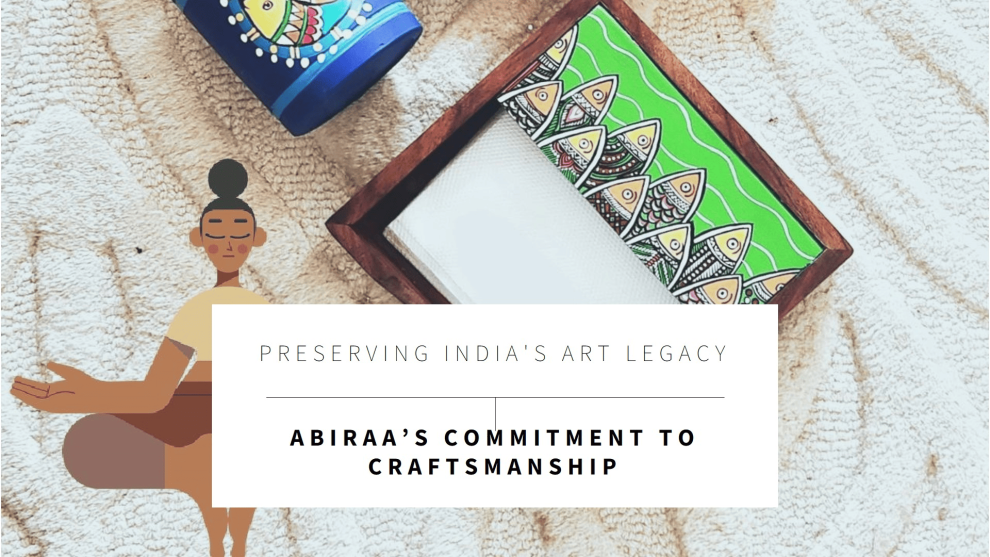India is a land of diverse cultures, traditions, and rich artistry. Yet, hidden in the rural landscapes, many tribal artisans struggle to make a livelihood despite their exceptional skills. Enter Abiraa, a social enterprise founded in 2017 by Sweta Singh with a mission to empower tribal artisans, preserve India’s artistic heritage, and create sustainable livelihoods.
Sweta Singh, an engineer with an MBA from Symbiosis Pune, turned her decade-long corporate expertise with Tata Group and HP into a journey of impact. “Empowering tribals to live a life with dignity and honour is my WHY!” she says, encapsulating the ethos of Abiraa.
The Birth of Abiraa: A Vision Rooted in Purpose
Founded with just ₹1 lakh, Abiraa began as a small platform to connect tribal artisans with markets. Over time, it blossomed into a venture that bridges the gap between traditional craftsmanship and modern consumers. Today, Abiraa collaborates with over 150 artisans, offering more than 300 unique products.
“We started with a dream to uplift rural artisans. Every product we make tells a story of culture, resilience, and creativity,” says Sweta Singh.

India’s Handicraft Market: A Growth Story
The Indian art and handicrafts market is projected to reach US$ 7,817.8 Million by 2032. Changing consumer attitudes toward sustainable and authentic products position Abiraa as a key player in this growing sector.
Market Trends Driving Demand
- Corporate Gifting: Companies increasingly seek socially responsible gifting solutions.
- Sustainable Products: Growing awareness about eco-friendly products fuels demand for handmade crafts.
- Cultural Revival: Urban consumers are reconnecting with India’s artistic heritage.
Impact Beyond Business
Abiraa doesn’t just sell products; it transforms lives. Key milestones include:
- Empowering over 150 tribal families across Jharkhand and neighboring states.
- Establishing partnerships with corporates for large-scale orders.
- Reviving endangered art forms through innovative product designs.
“At Abiraa, we believe that every artisan deserves recognition and respect for their work. Our mission is to bring their art to the forefront, not just as a product but as a legacy.” says, founder Sweta Singh
As Abiraa grows, it aims to:
- Expand into global markets, promoting Indian tribal art internationally.
- Develop an e-commerce platform to reach urban and international audiences directly.
- Partner with more organizations to support sustainable livelihoods.
Chart: Growth Projections for India’s Handicraft Market
| Year | Market Size (USD Million) | Growth Rate (%) |
|---|---|---|
| 2022 | 4,584.3 | 12.5 |
| 2027 | 6,200.0 | 14.8 |
| 2032 | 7,817.8 | 16.2 |
A Legacy of Tribal Art Forms
Abiraa features some of the most cherished tribal art forms in India:
- Gond Art (Madhya Pradesh): Known for its vibrant depictions of nature and folklore.
- Kalamkari (Gujarat): A delicate art form rooted in hand-painted textiles.
- Santhal Art (Jharkhand): Reflecting the culture of the Santhal tribes.
- Sohrai Art (Jharkhand): Traditionally used to decorate mud walls with symbolic motifs.
- Warli Art (Maharashtra): Iconic for its geometric patterns and depictions of tribal life.
Each art form tells a story of the community it represents, preserving cultural heritage through unique expressions.
Popular Tribal Art Forms and Their Features
| Art Form | Region | Key Features | Primary Materials |
|---|---|---|---|
| Madhubani | Bihar | Geometrical patterns, vibrant colors | Natural dyes, twigs |
| Dhokra | Multiple states | Brassware, lost-wax technique | Metal, clay molds |
| Kalamkari | Gujarat | Hand-painted, spiritual themes | Fabric, natural dyes |
| Sohrai | Jharkhand | Nature-inspired murals | Clay, charcoal |
| Gond | Madhya Pradesh | Storytelling, folk narratives | Acrylics, canvas |

Product Offerings: Where Tradition Meets Modernity
Abiraa’s product line caters to a wide range of customer preferences, combining functionality with aesthetics.
Home Décor and Utility Items
Enhance your living spaces with handcrafted pieces that bring warmth and character to your home:
- Blue Warli Coasters
- Seasoned Wooden Napkin Holders with Mithila Art
- Hand-Painted Wooden Frames
- Saura Art on Wooden Logs
- Round Table Lamps with Tribal Motifs
Artisanal Metal Crafts
Abiraa’s metal crafts reflect India’s centuries-old Dokra tradition, blending durability with artistic elegance:
- Brass Dokra Bottle Openers
- Tribal Couple Figurines
- Dokra Deer and Tortoise Sculptures
- Diya Hangings for Festive Décor
Jewelry Collection
The tribal jewelry collection features intricate designs handcrafted by rural artisans:
- Dokra Necklaces
- Tribal Pendants with Manjusha Art
- Handmade Earrings with a Rustic Finish
Customization and Collaboration
Abiraa offers bespoke services for customers looking to create personalized pieces:
- Custom Art Installations: Tailored to suit your interiors.
- Corporate Gifting: Unique, socially responsible gifting solutions for businesses.
- Collaborations with Designers: Co-create exclusive collections that blend tribal aesthetics with contemporary trends.
Empowering Tribal Communities: The Core of Abiraa’s Mission
At its heart, Abiraa is a social enterprise committed to:
- Economic Empowerment: Ensuring fair wages for over 150 artisans across India.
- Skill Development: Providing training programs to adapt traditional art forms to modern markets.
- Preservation of Heritage: Reviving endangered art forms and introducing them to new audiences.
“Our goal isn’t just to sell art; it’s to preserve a legacy while uplifting the lives of the artisans who create it.” says Sweta.
The Vision Behind Abiraa
Sweta Singh, the visionary founder of Abiraa, envisions a world where traditional arts are not only preserved but celebrated. “Our mission is to create a philosophy of aesthetics around tribal art,” says Singh. “We aim to bridge the gap between ancient craftsmanship and modern sensibilities while empowering the artisans who breathe life into these traditions.”
Abiraa works closely with artisans from across India, providing them with a platform to showcase their creativity and earn a sustainable livelihood. The brand’s philosophy is simple: What does good, looks good, and what looks good, does good.

Unveiling India’s Rich Tribal Heritage
1. Madhubani Paintings: The Forests of Honey
- Origin: Mithila region of Bihar.
- Distinctive Features: Geometrical patterns, vibrant colors, and depictions of deities, nature, and social events.
- Materials Used: Natural dyes, fingers, nib-pens, and twigs.
Madhubani paintings, traditionally crafted by women, are a visual representation of Mithila’s culture and spirituality. Abiraa collaborates with artisans to keep this art form alive, introducing it to a wider audience through curated collections.
2. Kalamkari Art: The Elegance of Gujarat
- Origin: Ahmedabad, Gujarat.
- Unique Tradition: Mata ni Pachhedi (backdrop) and Mata no Chandarvo (canopy).
- Color Palette: Black, maroon, and indigo with hand-painted borders.
This intricate textile art reflects the devotion and creativity of Gujarat’s Vaghari community. Abiraa’s Kalamkari offerings connect modern consumers to this deeply spiritual art form.
3. Dhokra Craft: The Lost Wax Legacy
- Origin: Madhya Pradesh, Bihar, Odisha, and West Bengal.
- Technique: Non-ferrous metal casting using the lost-wax process.
- Artisans: Situlias, Ghantaras, and other traditional craftsmen.
Dhokra art’s timeless beauty lies in its unique brassware designs. Abiraa’s Dhokra collection includes decor pieces that bring a rustic yet refined charm to any space.
4. Sohrai Art: Nature on Walls
- Origin: Hazaribagh, Jharkhand.
- Theme: Forests, people, and animals.
- Materials: Natural clays and charcoal.
This mural art celebrates the bond between tribal women and their natural surroundings. Abiraa transforms these wall paintings into contemporary art forms suitable for modern decor.
5. Gond Art: Tales of the Tribe
- Origin: Madhya Pradesh and neighboring states.
- Storytelling: Folk tales and cultural narratives form the backbone of every Gond painting.
- Aesthetic Appeal: Vibrant colors and intricate patterns.
Abiraa’s Gond art collection bridges traditional storytelling with contemporary design, making it a must-have for art connoisseurs.
Why Choose Abiraa?
1. Ethically Sourced Products
Abiraa ensures that every product is sourced directly from artisans, eliminating middlemen and ensuring fair pricing.
2. Unique and Handcrafted
Each piece is a labor of love, crafted by hand. No two items are alike, making every purchase truly special.
3. Sustainable Practices
Abiraa uses eco-friendly materials and promotes sustainable livelihoods, aligning with global environmental goals.
Beyond Art: Empowering Tribal Communities
Sweta Singh believes in the transformative power of art. By providing tribal artisans with access to global markets, Abiraa not only preserves cultural heritage but also uplifts entire communities. The brand invests in training programs, workshops, and infrastructure to support its artisans.
“Art is not just a medium of expression; it’s a way of life,” Sweta Singh emphasizes. “Our artisans are the custodians of India’s cultural soul, and we are here to ensure their legacy thrives.”
Abiraa’s Product Line: A Treasure Trove of Creativity
- Fine Art Paintings: From Madhubani to Warli, each painting tells a unique story.
- Home Decor: Metal crafts, hand-painted decor, and tribal-inspired accessories.
- Sustainable Gifts: Perfect for every occasion, blending tradition with modernity.
- Textiles: Exquisite fabrics featuring traditional block prints and hand-painted designs.
Abiraa’s Global Reach
With a robust online marketplace, Abiraa connects art lovers and collectors with India’s finest tribal art. Customers can explore and purchase:
- Original artworks.
- Customizable prints.
- Decor and lifestyle products.
Abiraa’s Impact in Numbers
- Artisan Engagement: Over 500 artisans empowered across India.
- Sustainable Products: 90% of offerings crafted from eco-friendly materials.
- Global Sales: Artworks shipped to over 30 countries.
A Booming Market for Indian Handicrafts
The global demand for Indian handicrafts is surging. The market is projected to grow from $4.58 billion in 2022 to $7.82 billion by 2032, driven by:
- Sustainability Trends: Growing preference for eco-friendly, handmade products.
- Corporate Gifting: Increasing demand for socially responsible gifting solutions.
- Cultural Revival: Rediscovery of India’s artistic heritage by urban and global audiences.
The Road Ahead: Abiraa’s Vision
Sweta Singh envisions Abiraa as a global ambassador for Indian tribal arts. Key future goals include:
- Global Market Expansion: Showcasing Indian tribal art internationally.
- E-Commerce Platform Development: Enabling direct access for urban and international buyers.
- Government Partnerships: Creating awareness and support for tribal artisans.
Sweta Singh sums it up beautifully:
“Our artisans are the custodians of India’s cultural soul. Through Abiraa, we bring their legacy to life and ensure it thrives in the modern world.”
Discover the Abiraa Difference
Step into a world where tradition meets innovation. Each Abiraa product embodies the resilience and creativity of India’s tribal communities, transforming homes and lives.
Explore Abiraa’s collections today and become part of a movement that celebrates India’s artistic legacy while uplifting the artisans who bring it to life.












Add Comment